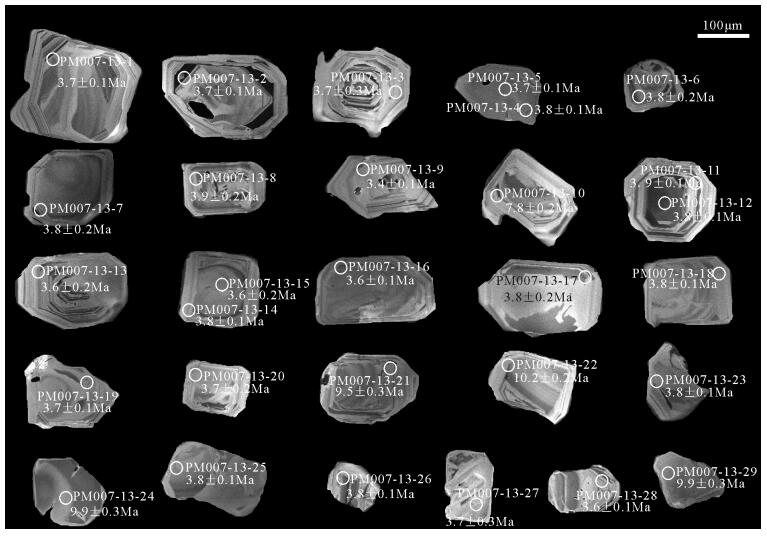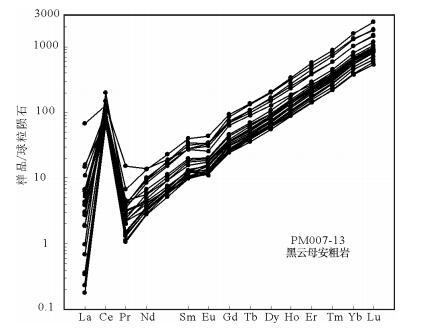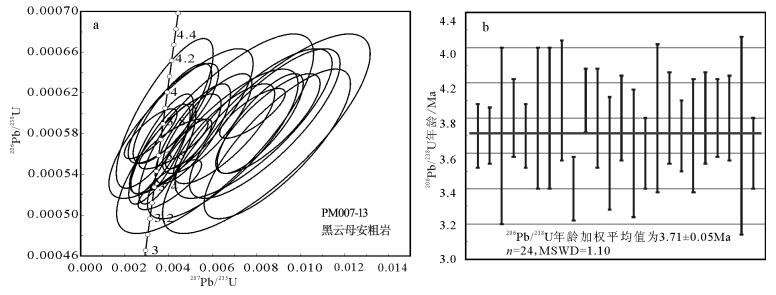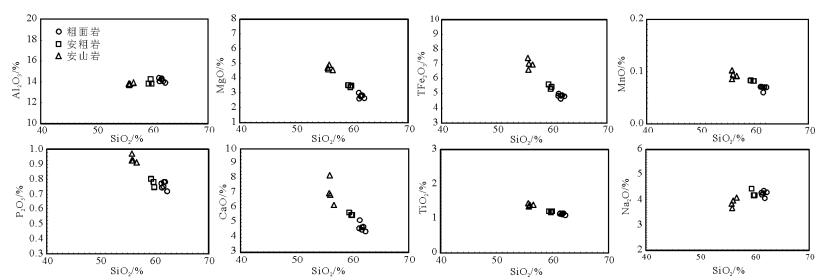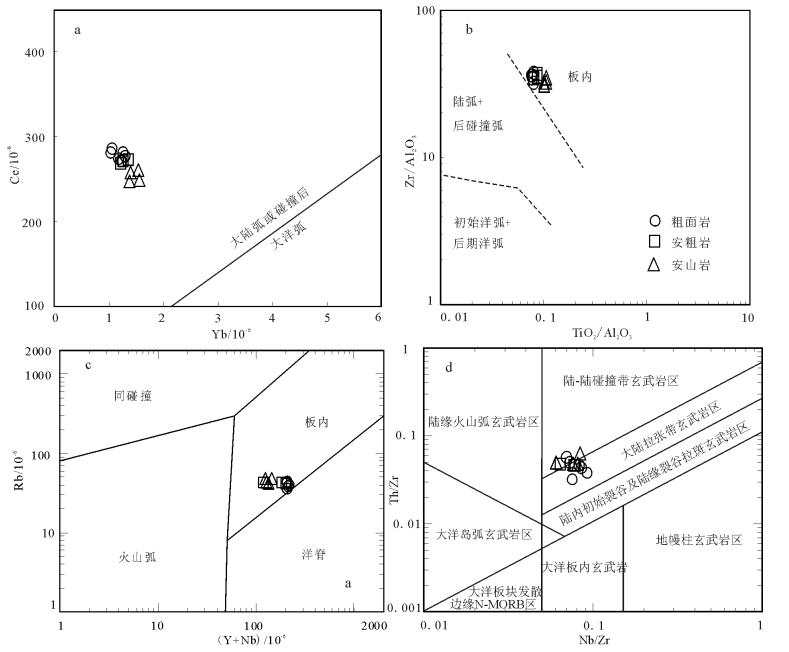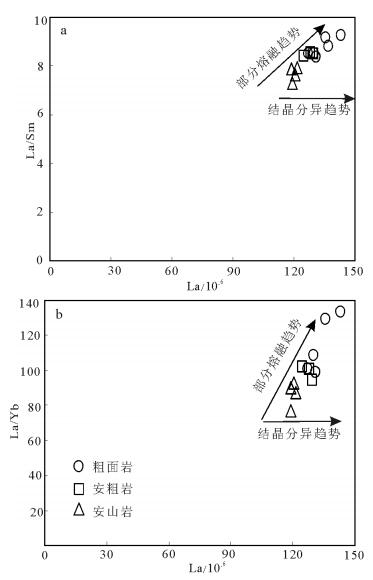LA-ICP-MS zircon U-Pb ages, geochemical characteristics and geo-logical significance of the Neogene Quanshuigou Formation volcanic rocks in the north of Dahongliutan-Qitaidaban area, Xinjiang
-
摘要:
出露于大红柳滩地区奇台达坂北侧的泉水沟组火山岩主要岩性为辉石安山岩、辉石安粗岩和黑云母粗面岩。用LAICP-MS技术测得黑云母安粗岩锆石U-Pb年龄为3.71±0.05Ma,形成时代为上新世。地球化学结果显示,岩石具高Al2O3(13.56%~14.32%)、高K2O(4.46%~5.79%)、高Na2O(3.68%~4.40%),低TiO2(1.09%~1.48%)、低MgO(2.64%~5.18%)的特征,属于钾玄岩序列。稀土元素总量为550×10-6~612×10-6,轻稀土元素总量较高且明显富集,重稀土元素相对亏损,具有右倾型特征和弱Eu异常(δEu=0.55~0.63)。微量元素中大离子亲石元素(K、Rb、Ba、Th、U、Pb)强烈富集,高场强元素(Ti、Nb、Ta、P)亏损,具有造山成因钾玄岩的典型特征。研究表明,泉水沟组火山岩来源于有上地壳卷入的部分熔融富集地幔区。结合区域特征,认为泉水沟组火山岩的形成与上新世喀喇昆仑-甜水海造山带沿大红柳滩-泉水沟断裂和甜水海-郭扎错断裂向NNW方向逆冲推覆有关。
Abstract:The Quanshuigou Formation volcanic rocks are located in northern Dahongliutan-Qitadaban area, western Kunlun Mountains, Xinjiang. The volcanic rocks are mainly composed of pyroxene andesite, pyroxene latite, and biotite trachyte. LA-ICPMS zircon dating indicates that the volcanic rocks were emplaced at 3.71 ±0.05Ma, suggesting that the crystallization age of the Quanshuigou Formation volcanic rocks is Neogene Pliocene. Geochemical analysis shows that major elements are characterized by high Al2O3 (13.56%~14.32%) and K2O (4.46%~5.79%), but low Na2O (3.68%~4.40%), TiO2 (1.09%~1.48%) and MgO (2.64%~5.18%), thus belonging to shoshonite series. In addition, they are enriched in total REE (550×10-6~612×10-6), and the samples are enriched in LREE (light rare earth elements) and depleted in HREE (heavy rare earth elements) with weak Eu anomalies (δEu=0.55~0.63). The chondrite-normalized REE patterns show rightly-inclined type, and the olcanic rocks have rich LILE(such as K, Rb, Ba, Th, U and Pb)but poor high field strength elements (such as Ti, Nb, Ta, and P). They have typical characteristics of orogenic potassic volcanic rocks.Studies show that the rocks were formed by the partial melting enriched mantle sources mixed with a small amount of materials of the upper crust. Combined with the data of regional geology, the authors hold that the formation of the orogenic belt was related to NNW-striking thrust nappe of Karakoram-Tianshuihai along Dahongliutan-Quanshuigou fault and TianshuihaiGuozhacuo fault in the Pliocene. At that time, the volcanic rocks were formed.
-
根据青藏高原新生代岩浆活动的大量研究,从南向北依次发育6条新生代岩浆岩带:喜马拉雅淡色二云母花岗岩带、冈底斯火山-侵入岩带、羌塘-囊谦火山岩带、可可西里火山岩带、西昆仑-东昆仑火山岩带和藏东滇西火山-深成侵入岩带[1-10]。青藏高原北部新生代火山岩的分布,西起喀喇昆仑,东至可可西里,绵延长逾1000km,南北介于昆仑山脉与玛依岗日-唐古拉山系之间,宽度200~300km[11]。分布在其中的西昆仑-东昆仑火山岩带是青藏高原北缘深部动力学过程的重要记录[10],主要发育一套钾质火山岩系,钾质火山岩是高原岩石圈构造演化特殊阶段的产物,其成因研究可以为探讨高原隆升机制提供重要的深部动力学信息[12-15]。有关钾质火山岩岩浆源区的性质和岩浆产生的机制一直存在较大的认识分歧:一种观点认为其起源于下地壳源区[15-19],另一种观点认为其起源于富集地幔[20]。本文对大红柳滩地区奇台达坂北侧泉水沟组灰白色含辉石安粗岩、粗面岩、辉石安山岩和安粗岩样品进行锆石U-Pb同位素、岩石学、地球化学研究,讨论该套火山岩的岩浆起源,进而对上新世西昆仑-喀拉昆仑造山带的构造演化提供约束。
1. 区域地质背景及岩石学特征
研究区地处西昆仑-喀喇昆仑造山带,位于巴颜喀拉晚古生代—中生代边缘裂陷带内,郭扎错-金沙江缝合带(多被第四系覆盖)从研究区西南部通过(图 1-a)。区内经历了长期的、多体制、多机制的构造演化,形成了复杂的构造格局和物质组成。上古生界—新生界均有分布,特别是二叠系—三叠系浅变质的沉积岩,新生界为半固结-松散状的砂砾土。岩浆岩主要有三叠纪和新近纪中酸性、酸性侵入岩及火山岩;构造主要有多机制、不同期次的面状和线状构造。研究区地层区划属巴颜喀拉地层区的大红柳滩地层分区(图 1-b),出露地层主要有二叠系黄羊岭群(PH)、三叠系巴颜喀拉山群(TB)及新近系泉水沟组的火山岩(N2q)和第四系沉积物。笔者在新疆西昆仑大红柳滩地区1:5万区域地质调查时,将二叠系黄羊岭群依据岩石组合特征进一步划分为4个段级地层单位:第一段(P1-2H11)、第二段(P1-2H12)、第三段(P1-2H13)、第四段(P1-2H14)。陕西省地质调查院在《新疆阿克萨依湖1:25万区域地质调查报告》①将三叠系巴颜喀拉山群分为3个组:下组(TB1)、中组(TB2)、上组(TB3)。本文基本沿用该划分方案,但在原有的基础上进行了补充,将下组分为2个段(TB11和TB12),中组分为2个段(TB21和TB22),上组分为2个段(TB31和TB32)②。
![]() 图 1 研究区构造格架简图(a)和地质简图及泉水沟组火山岩实测剖面位置(b)1—第四系;2—雪被区;3—新近系泉水沟组上段;4—新近系泉水沟组下段;5—巴颜喀拉山群中组下段;6—巴颜喀拉山群下组上段;7—黄羊岭群下砂板岩组第一段;8—黄羊岭群下砂板岩组第二段;9—黄羊岭群下砂板岩组第三段;10—黄羊岭群下砂板岩组第四段;11—黄羊岭群上砂板岩组第一段;12—奇台达坂构造片岩;13—印支晚期花岗岩;14—闪长玢岩脉;15—断层;16—采样位置;17—实测剖面位置及编号;18—研究区范围Figure 1. Tectonic framework sketch map (a) and geological sketch map of the study area and the profile position of the Quanshuigou Formation volcanic rocks (a)
图 1 研究区构造格架简图(a)和地质简图及泉水沟组火山岩实测剖面位置(b)1—第四系;2—雪被区;3—新近系泉水沟组上段;4—新近系泉水沟组下段;5—巴颜喀拉山群中组下段;6—巴颜喀拉山群下组上段;7—黄羊岭群下砂板岩组第一段;8—黄羊岭群下砂板岩组第二段;9—黄羊岭群下砂板岩组第三段;10—黄羊岭群下砂板岩组第四段;11—黄羊岭群上砂板岩组第一段;12—奇台达坂构造片岩;13—印支晚期花岗岩;14—闪长玢岩脉;15—断层;16—采样位置;17—实测剖面位置及编号;18—研究区范围Figure 1. Tectonic framework sketch map (a) and geological sketch map of the study area and the profile position of the Quanshuigou Formation volcanic rocks (a)研究区火山活动弱,火山岩分布局限,仅出露新近系泉水沟组火山岩,出露面积8.08km2,其产状较平缓,呈近椭圆形展布,依据岩石组合、火山岩相等将其划分为2个段:泉水沟组下段(N2q2),在调查区内滚石河南山坡上出露较全,基岩露头较好,岩性主要为深褐色黑云母粗安岩,与下伏二叠系黄羊岭群呈沉积不整合接触;泉水沟组上段(N2q1),在调查区内滚石河南山坡上及奇台达坂无名沟脑一带均有出露,在滚石河南坡出露较全,基岩露头较好。本文选择了一条具有代表性的剖面PM007(剖面起点坐标:北纬35°48′50″、东经79°27′20″)进行重点研究,岩性主要为暗红色块状含斑辉石安山岩、深褐色气孔状黑云母粗面岩、褐色块状含斑辉石安山岩,其与下伏新近系泉水沟组下段(N2q2)呈喷发不整合接触关系,上被第四系残坡积覆盖(图 2)。
黑云母粗面岩(图版Ⅰ-a):岩石具斑状结构,斑晶成分主要以钾长石为主,含量约占91%,斜长石、黑云母、透辉石、橄榄石较少(约9%),斑晶大小为0.3~5mm。钾长石及斜长石表面干净,呈自形板状,颗粒较粗大,含量约占12%。暗色矿物有黑云母、透辉石及橄榄石,大小为0.3~1mm,自形程度比长石好,黑云母又多析出铁质,其含量约占5%。基质为隐晶状结构,主要由钾长石组成,大小为0.01~ 0.02mm及0.1mm。除少量大小为0.1mm的斜长石杂乱分布外,基质钾长石质点呈土状,颗粒界线不清,又多具高岭土化、泥化及方解石化。
辉石安山岩(图版Ⅰ-b):岩石新鲜面呈红褐色,斑状结构、交织结构(基质),块状构造。主要矿物成分为斜长石(含氧化铁尘)(≥80%)、透辉石(10%)、浊沸石(8%)、黑云母( < 1%)、磁铁矿( < 1%)。斑晶成分为透辉石、斜长石及黑云母。透辉石、黑云母大小为0.2~1.5mm,呈自形晶出现,含量约10%。斜长石个体粗大,一般为1~2mm及5mm,常为半自形晶,含量约占3%。基质主要是由细小微板条状斜长石相互交错,围绕斑晶半定向排列分布,显示交织结构,并在斜长石间隙中含一些氧化铁尘,另外见大小为1~5mm的扁圆形气孔。部分被浊沸石充填,部分没有充填。
辉石安粗岩(图版Ⅰ-c):岩石分斑晶与基质两部分。岩石主要矿物成分为斜长(60%)、透辉石(3%)、钾长石(32%~34%)、黑云母(2%)。斑晶成分为斜长石、透辉石、黑云母。大小在0.2~3mm之间,总含量13%~14%。基质主要由微板条状斜长石组成,呈半定向排列分布,显示交织结构,在斜长石之间有微粒状钾长石充填。
2. 测试方法
本次选取调查区1件灰白色含辉石安粗岩样品(PM007-13-1RZ),采用LA-ICP-MS技术对其中的锆石进行U-Pb同位素测年;另外,在PM007剖面上选取4件辉石安山岩(PM007-1、PM007-4、PM007-5、PM007-6)、3件安粗岩样品(PM007-7、PM007-8、PM007-9)和6件粗面岩(PM007-10、PM007-11、PM007-12、PM007-13、PM007-14、PM007-15)进行主量、微量、稀土元素分析。
年龄样品原岩约15kg。锆石分选在核工业二〇三研究所完成,样品靶制备、显微照片拍摄、锆石U-Pb同位素分析、锆石微量元素分析在西北大学大陆动力学国家重点实验室完成。锆石U-Pb同位素、微量元素分析所用仪器为LA-ICP-MS。制靶时在双目镜下挑选晶形和透明度较好的颗粒,待样品靶打磨和抛光至锆石中心部位暴露后,拍摄反射光、透射光和阴极发光(CL)显微照片。分析仪器为美国Agilent公司生产的Agilent7500a型四极杆质谱仪和德国Microlas公司生产的Geolas200M型激光剥蚀系统,激光器为193nm ArF准分子激光器,激光波长为193nm,束斑直径为30μm,频率为8Hz,能量为70MJ,采样方式为单点剥蚀。锆石年龄计算采用标准锆石91500为外标,元素含量采用美国国家标准物质局人工合成硅酸盐玻璃NISTSRM610为外标,29Si为内标元素进行校正。数据采集处理采用GLITTER(Version4.0,Mcquaire University),并采用Andersen软件[21]对测试数据进行普通铅校正,加权平均值计算及U-Pb谐和图绘制采用Isoplot(3.0版)程序完成[22]。
主量、稀土、微量元素检测分析由核工业二〇三研究所分析测试中心完成。FeO采用容量法分析,依据标准GB/T14506.14-2010;其余主量元素、TFe2O3和微量元素P、Ba、V、Cr、Rb、Sr、Zr、Sc均采用XRF法分析,使用仪器为荷兰帕纳科公司制造的Axios X射线光谱仪,依据标准GB/T14506.28—2010;所有稀土元素及微量元素Co、Ni、Nb、Hf、Ta、Th、U采用ICP-MS法分析,使用仪器为Thermo Fisher Scientific公司制造的XSERIES2型ICP-MS,依据标准GB/T14506.30—2010;Fe2O3值通过计算得出,计算公式为TFe2O3=Fe2O3+FeO×1.1113。主量元素分析数据中,烧失量值介于0.41%~2.85%之间,总量在99.11%~99.47%之间,满足精度标准要求;主量元素分析误差小于1%,微量和稀土元素分析精度优于5%。
3. 锆石U-Pb同位素和稀土元素测定结果
3.1 锆石的CL图像及稀土元素特征
(1)锆石的CL图像
用于锆石U-Th-Pb同位素测年的样品采自泉水沟组黑云母安粗岩(PM007-13),采样位置为北纬79°38′15″、东经35°44′15″。岩石中的锆石以淡玫瑰色为主,个别呈淡灰绿色,强金刚光泽,锆石以次浑圆-浑圆状为主,棱角状-次棱角状次之,粒度一般在100× 50~450×250μm之间,长宽比主要为2,少量为1,个别为4,为短柱状晶形。由于个别锆石颗粒较大,在锆石分选过程中被破坏成不规则碎片。锆石颗粒呈半自形-他形,发育较清晰的岩浆结晶环带(图 3),锆石的Th、U含量分别为447×10-6~2134×10-6、452×10-6~ 2104×10-6,锆石的Th/U值介于0.61~1.11之间,以上特征均指示黑云母安粗岩为岩浆锆石成因。
(2)锆石稀土元素特征
锆石的稀土元素原位分析结果(表 2)显示,锆石稀土元素总量中等且变化范围较大(∑REE= 171×10-6~593×10-6),稀土元素分配模式图(图 4)显示,锆石具岩浆成因特征:左倾,轻稀土元素亏损、重稀土元素强烈富集,所有测点都存在明显的正Ce异常和微弱的负Eu异常,且异常变化范围较大(δEu=0.56~0.72,δCe=3.09~150.72),负Eu异常通常与岩浆演化过程中斜长石的结晶分异有关,还可能指示源区有斜长石残留;正Ce异常则可能是岩浆源区高氧逸度所致。
表 2 泉水沟组火山岩样品(PM007-13)锆石稀土元素含量Table 2. Rare earth elements data of zircon from Quanshuigou Formation volcanic rocks(PM007-13)10-6 原位稀土元素编号 La Ce Pr Nd Sm Eu Gd Tb Dy Ho Er Tm Yb Lu ∑REE ∑LREE/∑HREE δEu δCe 1 < 0.034 61.42 0.15 1.69 2.06 0.895 7.3 2.06 21.58 8.1 39.2 9.72 114.01 24.2 268.19 0.09 0.6 113.5 2 0.23 121.72 0.39 4.47 5.32 1.96 17.51 4.97 50.35 17.88 83.56 19.89 223.22 45.95 551.47 0.08 0.6 76.5 3 0.912 44.85 0.212 1.55 1.52 0.676 4.95 1.323 13.86 4.99 23.44 5.79 67.32 14.82 171.39 0.09 0.7 23.7 4 0.164 52.61 0.108 1.35 1.89 0.709 6.26 1.713 18.67 7.11 35.64 8.69 103.01 22.58 237.92 0.09 0.6 92.1 5 < 0.029 59.39 0.125 1.5 1.9 0.667 5.77 1.653 16.9 6.08 29.35 7.24 85.03 18.51 215.61 0.09 0.6 131.5 6 0.734 52.71 0.391 4.31 4.25 1.94 14.12 3.68 37.62 13.19 62.18 14.85 171.8 37.36 381.78 0.1 0.7 23.4 7 3.53 61.52 0.433 2.62 2.41 1.033 7.55 2.12 22.93 8.54 40.45 10.04 116.71 25.62 279.89 0.09 0.7 10.2 8 0.636 65.22 0.228 2.68 2.84 1.14 8.85 2.45 24.25 8.42 38.26 8.98 103.18 22.12 267.13 0.08 0.6 41.2 9 0.086 41.96 0.139 1.75 2.03 0.916 7.31 1.989 20.88 7.69 36.69 9.2 107.73 23.65 238.37 0.1 0.7 73.3 10 2.64 52.89 0.309 2.11 1.93 0.758 6.27 1.679 18.2 6.72 32.27 8.1 96.57 21.25 230.45 0.09 0.6 11.9 11 0.448 64.31 0.143 1.6 1.78 0.879 6.83 1.852 19.02 7.06 33.79 8.27 102.63 22.99 248.61 0.09 0.7 60.8 12 1.59 60.76 0.26 2.29 2.69 1.091 8.06 2.31 24.51 9.01 43.34 10.46 122.27 26.52 288.64 0.09 0.7 20.7 13 0.051 62.31 0.116 1.62 1.91 0.839 6.7 1.977 21.49 8.27 40.88 10.05 121.28 26.47 277.49 0.1 0.6 138.3 14 0.309 39.52 0.206 2.58 2.37 1.079 8.16 2.29 23.9 8.99 43.23 10.61 124.43 27.59 267.67 0.1 0.7 36.4 15 0.738 39.26 0.291 3.78 4.03 1.67 11.79 3.13 31.95 11.39 52.82 12.61 143.56 30.63 317.02 0.1 0.7 20.4 16 0.031 58.38 0.105 1.58 1.8 0.891 6.34 1.98 20.64 7.79 38.02 9.36 110.64 24.28 257.56 0.09 0.7 150.4 17 0.053 39.49 0.107 1.3 1.74 0.804 5.93 1.609 16.63 5.92 27.4 6.78 77.7 17.2 185.46 0.09 0.7 93.3 18 0.101 45.99 0.107 1.23 1.53 0.623 4.73 1.353 14 5.3 25.13 6.37 73.11 16.33 179.57 0.09 0.7 94.6 19 1.5 52.21 0.38 3.12 3.03 1.176 9.53 2.63 27.3 10.14 48.4 11.55 136.63 29.92 307.6 0.1 0.6 16.3 20 0.707 40.91 0.213 2.06 1.94 0.926 7.24 1.96 21.19 7.78 37.69 9.37 110.74 24.07 242.73 0.1 0.7 25.2 21 3.67 45.28 0.298 1.94 1.69 0.657 5.3 1.499 15.22 5.2 23.87 5.54 65.36 13.71 175.52 0.08 0.6 7.9 22 15.84 78.53 1.432 6.57 4.14 1.50 13.18 3.42 32.29 10.53 44.33 9.8 105.79 21.52 327.35 0.07 0.6 3.1 23 0.443 57.28 0.34 3.92 4.28 1.77 14.44 4.09 41.95 15.56 75.54 18.5 218.07 47.1 456.18 0.1 0.6 33.6 24 1.02 91.32 0.632 6.27 6.07 2.51 18.92 5.08 52.6 19.32 94.54 22.76 271.34 60.19 592.38 0.1 0.7 26.7 25 0.042 41.73 0.1 1.3 1.51 0.724 5.05 1.445 15.21 5.43 26 6.21 75.73 16.37 180.48 0.09 0.7 108.1 26 0.081 49.97 0.374 4.7 4.81 2.00 15.22 4.07 40.96 14.18 64.99 14.99 174.83 37.69 391.18 0.1 0.7 37.2 27 0.933 38 0.218 1.93 1.64 0.763 5.66 1.533 16.02 6.00 28.34 6.97 83.49 18.49 191.5 0.1 0.7 19.6 28 0.056 57.87 0.13 1.47 1.87 0.777 6.5 1.74 17.76 6.63 31.83 7.7 91.5 20.57 225.83 0.09 0.6 114.9 29 1.38 47.47 0.208 1.56 1.6 0.656 5.45 1.567 15.65 5.76 28.03 7.02 83.66 18.55 200.01 0.09 0.6 19.1 ![]() 图 4 黑云母安粗岩样品(PM007-13)锆石稀土元素配分模式图[23]Figure 4. Zircon REE patterns of biotite latite(PM007-13)
图 4 黑云母安粗岩样品(PM007-13)锆石稀土元素配分模式图[23]Figure 4. Zircon REE patterns of biotite latite(PM007-13)3.2 锆石的U-Pb定年
对样品PM007-13的26粒锆石进行了29个分析点测试(表 1)。其中24个测点的数据组成1个年龄密集区(图 5),206Pb/238U年龄加权平均值为3.71± 0.05Ma,该年龄值代表了泉水沟组黑云母安粗岩原岩的形成年龄。另外,5个测点(10、21、22、24、29)的数据在U-Pb谐和图中的投影位置偏离谐和线,且稀土元素分配模式也明显区别于其他测点,因此不参与年龄加权平均值的计算。由于207Pb/238U的测值问题,导致测点10的年龄值投影位置偏离谐和线。21、22、24、29号点介于锆石核部和环带之间,年龄值分别为9.5±0.3Ma、10.2±0.2Ma、9.9± 0.3Ma、9.5±0.3Ma,可能为混合年龄值,没有实际的地质意义。
表 1 泉水沟组火山岩样品(PM007-13)LA-ICP-MS锆石U-Th-Pb同位素分析结果Table 1. LA-ICP-MS zircon U-Th-Pb isotopic analyses of Quanshuigou Formation volcanic rocks(PM007-13)测点编号 元素含量/10-6 Th/U 同位素比值 表面年龄/Ma Pb Th U 207Pb/206Pb 1σ 207Pb/235U 1σ 206Pb/238U 1σ 207Pb/206Pb 1σ 207Pb/235U 1σ 206Pb/238U 1σ PM007-13-1 0.283 974 814 1.20 0.0473 0.0075 0.00375 0.00059 0.000570 0.000010 344 315 4.3 0.6 3.70 0.09 PM007-13-2 0.848 1913 2134 0.90 0.0674 0.0062 0.00531 0.00048 0.000570 0.000010 685 182 5.0 0.4 3.70 0.08 PM007-13-3 3.43 933 715 1.31 0.107 0.026 0.00492 0.00043 0.000570 0.000010 1741 384 8.5 2.0 3.70 0.25 PM007-13-4 0.44 1099 805 1.37 0.101 0.010 0.0085 0.0019 0.000580 0.000040 1647 180 8.3 0.8 3.80 0.11 PM007-13-5 0.409 1337 1156 1.16 0.0398 0.0063 0.00817 0.00080 0.000590 0.000020 0 0 3.2 0.5 3.70 0.09 PM007-13-6 0.838 1179 939 1.26 0.103 0.018 0.00319 0.00049 0.000580 0.000010 1680 294 8.5 1.4 3.80 0.20 PM007-13-7 0.469 1200 961 1.25 0.097 0.019 0.0084 0.0014 0.000590 0.000030 1565 325 8.0 1.5 3.80 0.20 PM007-13-8 0.723 1328 1205 1.10 0.046 0.011 0.00787 0.0015 0.000590 0.000030 7 493 3.9 0.9 3.90 0.17 PM007-13-9 0.304 976 785 1.24 0.0560 0.0083 0.00383 0.00090 0.000600 0.000030 453 300 4.1 0.6 3.40 0.09 PM007-13-10 2.674 1028 757 1.36 0.477 0.017 0.00406 0.00059 0.000530 0.000010 4172 52 77.9 2.0 7.80 0.15 PM007-13-11 0.597 1565 1255 1.25 0.0946 0.0079 0.07980 0.0021 0.001200 0.000020 1520 150 7.9 0.6 3.90 0.09 PM007-13-12 1.212 1272 1215 1.05 0.081 0.012 0.00782 0.00061 0.000600 0.000010 1229 269 6.6 1.0 3.80 0.14 PM007-13-13 0.325 1281 880 1.46 0.055 0.011 0.00653 0.00094 0.000580 0.000020 422 397 4.4 0.9 3.60 0.16 PM007-13-14 0.28 864 650 1.33 0.070 0.010 0.00431 0.00085 0.000570 0.000020 940 277 5.8 0.8 3.80 0.12 PM007-13-15 0.494 800 781 1.03 0.083 0.018 0.00576 0.00083 0.000590 0.000020 1268 381 6.5 1.4 3.60 0.18 PM007-13-16 0.271 1216 738 1.65 0.0464 0.0075 0.0065 0.0014 0.000570 0.000030 17 348 3.6 0.6 3.60 0.10 PM007-13-17 0.337 864 684 1.26 0.0559 0.017 0.00359 0.00057 0.000560 0.000020 448 553 4.6 1.4 3.80 0.21 PM007-13-18 0.427 999 709 1.41 0.051 0.010 0.0046 0.0013 0.000590 0.000030 256 408 4.3 0.9 3.80 0.13 PM007-13-19 0.342 1119 918 1.22 0.0470 0.0075 0.00422 0.00084 0.000600 0.000020 47 342 3.8 0.6 3.70 0.10 PM007-13-20 0.605 855 638 1.34 0.113 0.018 0.00371 0.00058 0.000570 0.000020 1849 263 9.0 1.4 3.70 0.16 PM007-13-21 2.288 921 675 1.36 0.5039 0.0235 0.0090 0.0014 0.000570 0.000030 4253 67 99.4 3.4 9.50 0.25 PM007-13-22 3.74 1040 818 1.27 0.526 0.018 0.1029 0.0037 0.001500 0.000040 4316 48 110.0 2.5 10.20 0.19 PM007-13-23 0.673 1447 1077 1.34 0.105 0.013 0.1144 0.0027 0.001600 0.000030 1707 206 8.6 1.0 3.80 0.13 PM007-13-24 7.47 2104 1611 1.31 0.531 0.027 0.00852 0.00097 0.000590 0.000020 4329 71 107.8 3.9 9.90 0.28 PM007-13-25 0.379 993 704 1.41 0.0634 0.0090 0.1121 0.0043 0.00150 0.000040 723 274 5.2 0.7 3.80 0.11 PM007-13-26 0.478 1234 1163 1.06 0.0509 0.0090 0.00511 0.00070 0.000580 0.000020 237 364 4.2 0.7 3.80 0.12 PM007-13-27 0.739 781 594 1.31 0.077 0.024 0.00418 0.00073 0.000600 0.000020 1113 517 6.2 1.8 3.70 0.28 PM007-13-28 0.344 1366 1020 1.34 0.0510 0.0071 0.0061 0.0018 0.000580 0.000040 239 292 4.0 0.5 3.60 0.10 PM007-13-29 1.484 964 664 1.45 0.524 0.024 0.00395 0.00053 0.000560 0.000020 4309 65 106.8 3.5 9.90 0.25 4. 岩石地球化学特征
4.1 主量元素
泉水沟组火山岩岩石化学成分见表 3。烧失量(LOI)为0.43%~3.05%,对主量元素扣除烧失量后重新换算成100%再进行投图。根据主量元素SiO2的含量及Mg#、部分微量元素含量的不同,可将其分为2组:中基性火山岩组(SiO2含量为55.77%~56.63%)和中性火山岩组(SiO2含量为59.39%~62.31%)。中基性火山岩组的MgO含量为4.56%~4.91%,平均值为4.73%;Mg#值为53.33~55.42;Al2O3含量为13.73%~ 13.93%,平均值为13.83%;K2O含量为4.57% ~ 4.92%,平均值为4.74%;Na2O含量为3.68%~4.10%,平均值为4.09%;TiO2含量为1.37%~1.46%,平均值为1.42%;A/CNK值为0.53~0.60。中性火山岩组的MgO含量低,为2.64%~3.51%,平均值为3.01%;Mg#值低,为48.58~53.14;Al2O3含量高,为13.8% ~ 14.32%,平均值为14.05%;K2O含量高,为5.38%~ 5.79%,平均值为5.57%;Na2O含量高,为4.05% ~ 4.41%,平均值为4.24%;TiO2含量较低,为1.09%~ 1.21%,平均值为1.15%;A/CNK值为0.59~0.67。
表 3 泉水沟组火山岩岩石化学成分Table 3. Chemical compostion of Quanshuigou Formation volcanic rocks样品号 PM007-1 PM007-4 PM007-5 PM007-6 PM007-7 PM007-8 PM007-9 PM007-10 PM007-11 PM007-12 PM007-13 PM007-14 PM007-15 岩性 辉石安 辉石安 辉石安 辉石安 辉石安 辉石安 辉石安 黑云母 黑云母 黑云母 黑云母 黑云母 黑云母 山岩 山岩 山岩 山岩 粗岩 粗岩 粗岩 粗面岩 粗面岩 粗面岩 粗面岩 粗面岩 粗面岩 SiO2 53.72 53.75 55.73 54.55 57.27 58.12 58.40 60.50 61.71 61.16 61.07 61.41 60.6 TiO2 1.36 1.43 1.39 1.43 1.16 1.17 1.14 1.12 1.08 1.12 1.10 1.13 1.13 Al2O3 13.26 13.55 13.71 13.54 13.31 13.41 13.88 14.15 13.72 14.03 14.16 13.88 13.85 Fe2O3 5.02 6.09 4.82 5.10 3.94 3.96 3.78 3.48 4.06 3.55 3.36 3.45 4.49 FeO 1.95 1.05 2.30 2.40 1.61 1.44 1.55 1.46 0.76 1.16 1.57 1.53 0.48 MgO 4.72 4.90 4.49 4.66 3.38 3.35 3.28 2.97 2.65 2.80 2.76 2.82 2.61 MnO 0.09 0.09 0.09 0.10 0.08 0.08 0.08 0.07 0.07 0.06 0.07 0.07 0.07 CaO 6.61 7.03 6.10 6.84 5.47 5.34 5.36 4.55 4.34 4.44 4.63 4.65 5.08 Na2O 3.81 3.81 4.03 3.77 4.25 4.04 4.05 4.22 4.25 4.31 4.21 4.02 4.14 K2O 4.53 4.32 4.84 4.47 5.19 5.30 5.34 5.54 5.69 5.74 5.41 5.41 5.67 P2O5 0.89 0.92 0.90 0.95 0.77 0.72 0.76 0.76 0.71 0.77 0.74 0.77 0.73 烧失量 3.05 2.08 1.13 1.48 2.54 1.89 1.37 0.83 0.42 0.45 0.47 0.49 0.71 总量 99.01 99.02 99.53 99.29 98.97 98.82 98.99 99.65 99.46 99.59 99.55 99.63 99.56 Mg# 55.38 55.38 53.71 53.33 52.75 53.14 53.04 52.47 49.89 52.06 50.74 50.97 48.58 K2O+Na2O 8.69 8.39 9.01 8.42 9.79 9.64 9.62 9.88 10.04 10.14 9.71 9.51 9.92 La 119 119 122 121 130 128 125 131 136 130 137 127 143 Ce 258 261 258 263 272 271 267 277 281 274 282 271 286 Pr 28.6 29.6 29.1 29.7 29.1 29.4 28.7 29.4 29.6 28.9 30.8 29.3 31.2 Nd 104 108 105 108 103 104 102 105 103 102 108 105 110 Sm 15.1 16.4 15.4 15.8 15.2 15.0 14.9 15.7 14.8 15.3 15.6 15.0 15.5 Eu 2.9 2.9 3.0 3.0 2.7 2.9 2.7 2.7 2.6 2.6 2.7 2.7 2.7 Gd 13.1 13.6 13.7 13.2 13.1 13.0 12.8 13.0 13.0 12.5 13.6 12.8 13.8 Tb 1.09 1.12 1.13 1.12 1.03 1.01 1.00 1.04 1.04 0.99 1.09 1.05 1.06 Dy 4.7 5.2 4.9 5.0 4.3 4.5 4.4 4.4 4.2 4.2 4.6 4.2 4.2 Ho 0.66 0.74 0.66 0.71 0.63 0.65 0.61 0.57 0.56 0.61 0.64 0.57 0.60 Er 2.04 2.33 2.21 2.11 2.01 1.95 2.06 1.86 1.80 1.83 1.92 1.92 1.75 Tm 0.21 0.22 0.21 0.21 0.20 0.21 0.18 0.18 0.15 0.18 0.18 0.18 0.16 Yb 1.32 1.55 1.39 1.30 1.38 1.28 1.23 1.32 1.05 1.20 1.28 1.26 1.07 Lu 0.17 0.19 0.18 0.16 0.16 0.16 0.16 0.16 0.13 0.16 0.15 0.17 0.12 Y 19.8 20.9 20.1 21.1 19.3 18.8 18.4 18.4 17.2 17.8 18.9 18.1 17.8 Cu 23.5 26.6 21.4 25.1 35.2 29.3 16.7 16.7 12.6 13.7 17.7 17.9 11.3 Pb 49.2 47.4 38.5 37.4 77.9 80.1 48.2 57.0 28.7 37.8 39.7 67.9 27.9 Zn 82.0 127 64.9 64.7 175 99.5 92.0 123 65.3 50.2 60.6 96.9 64.8 Co 23.4 23.5 21.4 21.8 13.3 23.2 14.0 13.6 12.4 12.2 14.2 12.5 11.3 Ni 85.2 85.0 77.9 77.6 61.7 86.0 65.0 67.0 57.2 59.8 71.4 61.2 54.0 Cr 86.4 86.1 91.2 99.5 77.3 101 74.7 71.0 65.8 58.1 67.7 71.7 53.1 V 78.7 74.9 91.8 86.6 64.6 102 61.0 62.0 60.7 55.6 59.7 68.4 47.1 Ga 20.9 20.7 19.1 17.8 20.6 20.1 18.9 19.4 20.1 19.8 21.2 20.6 18.9 Sr 1701 1686 1440 1514 1520 1732 1354 1398 1363 1360 1374 1383 1343 Ba 2141 2057 2259 2333 2083 2415 2287 2328 2274 2246 2239 2233 2236 Rb 127 124 146 134 185 122 205 216 211 220 209 211 211 Nb 22.5 27.2 26.8 20.4 22.7 22.2 21.3 19.3 24.1 20.9 23.1 16.5 25.0 Ta 1.64 1.64 1.84 1.63 2.03 1.31 1.08 0.98 1.60 1.38 1.55 0.86 1.33 Zr 461 460 435 431 507 486 487 514 494 487 507 521 447 U 9.3 9.3 10.2 9.3 11.4 9.5 11.8 14.1 11.0 12.5 12.5 12.2 10.4 Th 28.0 33.1 36.4 33.2 40.0 31.5 38.2 47.6 36.2 41.7 41.9 39.6 31.1 Ag 1.46 1.53 1.43 1.39 1.50 1.61 1.45 1.37 0.50 0.93 1.94 1.10 0.17 Au 0.50 0.42 1.13 0.43 1.20 0.35 0.43 0.70 0.45 0.83 0.88 0.91 0.76 ∑REE 550 561 556 564 575 573 563 584 589 574 600 572 612 LREE 527 537 531 541 552 550 540 561 567 553 576 550 589 HREE 23.3 25.0 24.4 23.8 22.8 22.8 22.4 22.5 21.9 21.7 23.5 22.2 22.8 δEu 0.61 0.57 0.61 0.63 0.57 0.62 0.59 0.57 0.55 0.56 0.55 0.59 0.56 δCe 1.03 1.03 1.01 1.03 1.03 1.02 1.03 1.03 1.02 1.03 1.00 1.03 0.99 注:主量元素含量单位为%,微量和稀土元素含量为10-6 在TAS图解(图 6-a)上,中基性火山岩组以辉石安山岩为主;中性火山岩组以粗面安山岩、粗面岩为主。在SiO2-K2O图解(图 6-b)上,中基性火山岩组投到钾玄岩与橄云安粗岩过渡区域,中性火山岩组全部落在橄云安粗岩区域,两组岩石均属于钾玄岩系列。在Harker图(图 7)中,MgO、TFe2O3、MnO、P2O5、CaO、TiO2含量随SiO2含量的增加迅速减少,反映了泉水沟组火山岩不同岩性之间为同源岩浆演化关系,且岩浆演化早期存在以橄榄石和单斜辉石为主的分离结晶作用,由于镁铁质的橄榄石和单斜辉石中Al2O3的含量非常低,因此橄榄石和单斜辉石的分离结晶作用会降低残余熔体MgO和相容元素(Cr、Ni等)的含量,使残余熔体中的Al2O3增高。该套火山岩具有斑状结构正好证明了这一观点,斑状结构指示岩浆在地壳深部有过停留,斑晶矿物组合代表岩浆的深部结晶相,该套火山岩斑晶主要为斜长石+黑云母+透辉石+橄榄石组合,橄榄石、单斜辉石斑晶的分离与早期岩石中的Fe、Mg、Ca的降低趋势一致。P2O5和TiO2含量的降低可能与磷灰石和钛铁氧化物的分离结晶作用有关;Na2O变化与SiO2呈弱的正相关。
4.2 微量和稀土元素
泉水沟组火山岩微量和稀土元素测试结果见表 3。从表 3可以看出,泉水沟组火山岩稀土元素总量∑REE较高,为550×10-6~612×10-6,LREE/ HREE=21.5~25.9。泉水沟组火山岩具有相似的稀土元素配分模式(图 8-a),在球粒陨石标准化配分模式图解上,泉水沟组火山岩的轻稀土元素(LREE)明显富集,重稀土元素(HREE)相对亏损,轻稀土元素与重稀土元素强烈分异,(La/Yb)N=51.76~90.10,LREE分异较明显,(La /Sm)N=4.46~ 5.80,HREE分异不明显。Eu具有弱负异常(δEu=0.55~0.63),可能为源区受地壳混染引起[29]。在配分曲线上出现显著的V型谷,总体为平滑的右倾型。
在微量元素蛛网图(图 8-b)中,泉水沟组火山岩显示出强烈富集K、R b、Ba和Th、U、Pb等大离子亲石元素(LILE),相对亏损高场强元素(HFSE),尤其是Ti、Nb、Ta和P出现明显的负异常,暗示在成岩过程中有壳源物质的加入,具有造山成因钾质火山岩的典型特征[29-32]。此外,泉水沟组粗面岩中相容元素Cr、Ni含量分别为53×10-6~101×10-6、54×10-6~ 86×10-6,明显低于超钾质火山岩[19, 33-34],而与地壳的平均含量相当[35]。
5. 讨论
5.1 构造环境分析
前面所述,泉水沟组火山岩是一套碱性系列的钾玄岩系列火山岩。钙碱性火成岩组合发育于挤压造山带[36],而钾玄岩系列是大陆碰撞造山带的典型组合[28]。前人研究认为,青藏高原北部存在类似于藏南喜马拉雅陆内俯冲带那样的另一条巨大的陆内俯冲带。青藏高原北部的新生代火山岩根据不同的动力学背景划分为南、北2个亚带[1-2]:北亚带形成于挤压环境,南亚带形成于拉张环境,并因此提出2种不同的火山岩成因模式,即陆向俯冲和初始板内裂谷。
泉水沟组火山岩岩石地球化学数据(表 3)显示,岩石具有高度富集HILE和高度亏损HFSE,以及由此产生的较高的Ba/Nb值(76~135,明显高于28)和较低的Nb/Y值(1.1~1.4),均表现了活动陆缘岩浆作用的特征[37-38]。Ce/Yb值介于195.5~ 267.6之间,明显不同于大洋弧钾质火山岩[31]。在Logτ-Logσ图解(图 9-a)中,火山岩全部落在造山带与派生区相邻区域。在TFeO-MgO-Al2O3图解(图 9-b)中,样品全部落在造山带区域。在Ta/ Yb-Th/Yb(图 9-c)和Nb×100/Zr-Th×100/Zr图解(图 9-d)中,火山岩全部落在造山成因的火山岩区。在Yb-Ce图解(图 10-a)中,样品点全部落入大陆弧与碰撞后区域,在TiO2/Al2O3-Zr/Al2O3图解(图 10-b)中,样品点全部落在板内;在(Y+ Nb)-Rb图解(图 10-c)中,样品点也全部落在板内;在Nb/Zr-Th/Zr图解(图 10-d)中,样品点落在陆陆碰撞带与大陆拉张带的交界处。综上所述,本次研究的泉水沟组火山岩形成于碰撞后的板内造山构造环境。
5.2 岩石源区讨论
泉水沟组火山岩岩石学特征和岩石化学特征显示,SiO2>56%,Al2O3>13%,MgO<3%(个别大于3%),Sr>400×10-6,Y<20×10-6,Yb<1.9×10-6,具有典型的埃达克岩/埃达克质岩石的地球化学特征,在图解Y-Sr/Y(图 11)中,所有样品投点也几乎落在埃达克质岩石区域附近。目前的研究表明,埃达克岩/埃达克质岩一般有以下几种成因模式:① 与俯冲的大洋板片熔融相关的埃达克岩[44-46];② 玄武质岩浆的同化和分离结晶作用形成的埃达克质岩[47];③ 镁铁质下地壳部分熔融形成的埃达克质熔体[17, 44-45, 48-49]。
![]() 图 11 泉水沟组火山岩Y-Sr/Y图解(底图据参考文献[44])Figure 11. Y-Sr/Y diagram of the Quanshuigou formation volcanic rocks
图 11 泉水沟组火山岩Y-Sr/Y图解(底图据参考文献[44])Figure 11. Y-Sr/Y diagram of the Quanshuigou formation volcanic rocks印度板块持续向北挤压,使青藏高原地壳逐渐加厚和抬升。通过地震观测资料的反演,张雪梅等[50]得出,巴颜喀拉块体和松潘-甘孜地块块体的地壳厚度为65~55km,岩石圈厚度为160~ 150km,软流层厚度为180~140km。这种不协调的壳-幔结构不是固有和不变的,增厚超过临界值(近50km),则密度大的岩石圈沉陷到密度小而热的软流圈中,从而引起岩石圈的拆沉,软流圈的物质为了填补亏损的空间,向压力降低的方向运动和上侵,致使残留岩石圈底部遭受热侵蚀,并诱发“壳-幔混合层”的部分熔融[3]。在Al2O3-MgO(图 12-a)和Ne'-Ol'-Q'(图 12-b)图解中,岩浆形成的温度为1100~1200℃,形成压力约为1GPa,与可可西里-西昆仑带钾质火山岩的形成温度为900~ 1200℃一致[20]。在Sr-Rb图解(图 12-c)中,岩石岩浆源区之上的地壳厚度大于30km,在SiO2-K2O图解(图 12-d)中,源区深度约250km。由此看来,研究区基性-中基性火山岩岩浆形成于地壳-地幔之间,为青藏高原北部新生代陆-陆造山碰撞后拆沉岩浆作用的产物。
![]() 图 12 Al2O3-MgO图解(a)、Ne'-Ol'-Q'图解(b)(a、b,底图分别据参考文献[51]和[52])、Sr-Rb图解(c)和SiO2-K2O图解(d)(c、d,底图据参考文献[53])Ne—霞石;Ol—橄榄石;Q—石英;En—顽火辉石;Jd—硬玉;Ab—钠长石;Hy—紫苏辉石;Ol'=Ol+3/4×Hy;Ne'=Ne+3/5×Ab;Q'=Q+2/5×Ab+1/4×HyFigure 12. Al2O3-MgO (a), Ne'-Ol'-Q' (b), Sr-Rb (c) and SiO2-K2O (d) diagrams for Quanshuigou Formation volcanic rocks
图 12 Al2O3-MgO图解(a)、Ne'-Ol'-Q'图解(b)(a、b,底图分别据参考文献[51]和[52])、Sr-Rb图解(c)和SiO2-K2O图解(d)(c、d,底图据参考文献[53])Ne—霞石;Ol—橄榄石;Q—石英;En—顽火辉石;Jd—硬玉;Ab—钠长石;Hy—紫苏辉石;Ol'=Ol+3/4×Hy;Ne'=Ne+3/5×Ab;Q'=Q+2/5×Ab+1/4×HyFigure 12. Al2O3-MgO (a), Ne'-Ol'-Q' (b), Sr-Rb (c) and SiO2-K2O (d) diagrams for Quanshuigou Formation volcanic rocks研究表明,当用某亲湿岩浆元素(H)与亲岩浆元素(M)浓度比值对亲湿岩浆元素作图时,平衡部分熔融的轨迹是一条倾斜线,而分离结晶作用则为一条水平线[1],当源区发生低度部分熔融时,La优先进入熔体,即La的丰度始终比Sm、Yb的浓度增加的快,因此La-Sm构成正相关的线性关系;在分离结晶作用中,La和Sm几乎是同步增长,故构成近水平的线性关系(图 13),因此该套火山岩主要以部分熔融作用为主。
![]() 图 13 La-La/Sm(a)和La-La/Yb(b)图解(底图据参考文献[54])Figure 13. La-La/Sm (a) and La-La/Yb (b) diagrams for Quanshuigou Formation volcanic rocks
图 13 La-La/Sm(a)和La-La/Yb(b)图解(底图据参考文献[54])Figure 13. La-La/Sm (a) and La-La/Yb (b) diagrams for Quanshuigou Formation volcanic rocks在主量元素Harker图解(图 7)中,研究区钾质岩的MgO、TFe2O3、MnO、P2O5、CaO、TiO2和SiO2呈明显的负相关关系,表明在岩浆演化过程中,可能有橄榄石、单斜辉石、钛-铁氧化物、磷灰石等矿物的结晶分异[34]。SiO2-Mg#图解(图 14-a)显示幔源岩浆与地壳物质相互作用的壳-幔(混合)岩浆趋势。Nb/Y-Rb/Y图解(图 14-b)显示垂直变化趋势,表明幔源受到外来物质的交代[38]。在La/Yb-Yb图解(图 14-c)中,研究区钾质火山岩都来自富集的地幔源区,其中一些可能来自尖晶石相和石榴子石相混合幔源区,这一特点与青藏高原其他地区钾质、超钾质火山岩的特征类似[13, 15]。
5.3 地质意义
印度与亚洲大陆碰撞发生在55Ma左右[55],到45Ma或40Ma左右完成,之后转入两大板块碰撞后的陆内构造演化阶段[15, 56]。晚新生代青藏高原西北缘造山运动频繁,陈正乐等[57]通过磷灰石裂变径迹测年得到在阿尔金地区岩石8Ma快速冷却;柴达木盆地在8.1Ma沉积速率增大[58],从河西走廊酒西盆地的沉积演化和古地磁测年结果推断,青藏高原北缘在8.2Ma由稳定隆升转变为持续逐步较快速的隆升。李海兵等[59]对喀喇昆仑断裂、鲜水河断裂、红河断裂研究也表明,在该时期发生了较强烈的活动。肖爱芳等[60]在泉水沟北与火山岩接触烘烤的花岗岩中采集磷灰石,裂变径迹年龄为7.9±1.0Ma。区域上,沿康西瓦-大红柳滩-泉水沟断裂分布一系列的火山岩,均发生在8~9Ma:大红柳滩火山岩年龄为7.97Ma[61]、奇台达坂火山岩年龄为8.3±0.3Ma[60]、阿克萨依湖地区玄武岩年龄为8.0±0.1Ma[33]。因此笔者认为,阿克萨依湖幅1:25万区域地质调查① 发现的奇台达坂火山岩泉水沟组火山岩为第一次喷发的产物。
黎敦朋等[62]在布雅-恰哈向斜中发现阿图什组与乌恰群帕卡布拉克组呈微角度不整合接触,桑株河阿图什组底界年龄为5.3Ma[63],柯克亚阿图什组底界年龄为4.5Ma[61],因此,该沉积间断发生于5.3~ 4.5Ma,在乌鲁克萨依河糜棱岩化花岗岩中也获得了5.1±0.9Ma的磷灰石裂变径迹年龄,说明西昆仑北缘断裂在5±Ma发生逆冲抬升事件。此时,喀喇昆仑断裂发生右旋走滑运动,康西瓦断裂发生左旋走滑运动,夹持于喀喇昆仑断裂与康西瓦断裂之间的喀喇昆仑-甜水海造山带东部沿大红柳滩-泉水沟断裂和甜水海-郭扎错断裂向NNW方向逆冲推覆。Arnaud等[7]在泉水沟地区测得的粗面岩K-Ar年龄为3.3Ma;万渝生等[64]在康西瓦地区获得的碱性玄武岩锆石U-Pb年龄为3.82Ma;王权等[65]在黑石北湖地区对安粗岩进行了40K-40Ar测年,获得的平均年龄为3.19Ma;李金冬等[66]在银石山地区获得的流纹岩中的白云母40K-40Ar平均年龄为3.65± 0.31Ma。本次对奇台达坂北侧泉水沟组黑云母安粗岩进行了锆石U-Pb测年,获得的年龄加权平均值为3.71±0.05Ma,属于新近纪上新世。以上火山岩分布地点明显受大红柳滩-泉水沟断裂带、康西瓦断裂带等深大断裂带的控制。
由于印度板块的持续俯冲,拉萨地块的岩石圈地幔在渐新世早期沿班公湖-怒江缝合带向南羌塘陆块之下俯冲,俯冲板块在35Ma作用发生断离[5, 15],上地壳物质由于古俯冲作用进入岩石圈地幔,经演化形成富集地幔源区,在新近纪上新世受到强烈的热扰动而发生部分熔融,这些部分熔融体的岩浆沿着康西瓦-大红柳滩-泉水沟断裂上升到地表,形成中基性-中性火山岩。
6. 结论
(1)奇台达坂北侧火山岩岩性主要为辉石安山岩、辉石(黑云母)安粗岩、黑云母粗面岩,为一套中基性-中性火山岩,属于钾玄岩序列火山岩。黑云母安粗岩锆石U-Pb年龄为3.71±0.05Ma,为上新世。
(2)泉水沟组火山岩地球化学特征显示,岩石具有高Al2O3、K2O、Na2O,低TiO2、MgO,强烈富集K、Rb、Ba和Th、U、Pb等大离子亲石元素,相对亏损高场强元素,尤其是Ti、Nb、Ta和P出现明显的负异常,轻稀土元素明显富集,重稀土元素相对亏损,负Eu异常不明显,具有造山成因钾质火山岩的典型特征。
(3)泉水沟组火山岩具有一些类似于埃达克质熔体成分的特征,来源于有上地壳物质卷入的富集地幔区部分熔融。
(4)泉水沟组火山岩形成于板内造山环境。为上新世喀喇昆仑-甜水海造山带沿大红柳滩-泉水沟断裂和甜水海-郭扎错断裂向NNW方向逆冲推覆的产物。
致谢: 锆石阴极发光照相和锆石U-Pb同位素测试分别得到西北大学大陆动力学国家重点实验室弓化栋老师的帮助,薄片鉴定得到核工业二〇三研究所陈存善老师的帮助,审稿专家对本文提出了宝贵的修改意见,在此一并表示感谢。 -
图 1 研究区构造格架简图(a)和地质简图及泉水沟组火山岩实测剖面位置(b)
1—第四系;2—雪被区;3—新近系泉水沟组上段;4—新近系泉水沟组下段;5—巴颜喀拉山群中组下段;6—巴颜喀拉山群下组上段;7—黄羊岭群下砂板岩组第一段;8—黄羊岭群下砂板岩组第二段;9—黄羊岭群下砂板岩组第三段;10—黄羊岭群下砂板岩组第四段;11—黄羊岭群上砂板岩组第一段;12—奇台达坂构造片岩;13—印支晚期花岗岩;14—闪长玢岩脉;15—断层;16—采样位置;17—实测剖面位置及编号;18—研究区范围
Figure 1. Tectonic framework sketch map (a) and geological sketch map of the study area and the profile position of the Quanshuigou Formation volcanic rocks (a)
图 4 黑云母安粗岩样品(PM007-13)锆石稀土元素配分模式图[23]
Figure 4. Zircon REE patterns of biotite latite(PM007-13)
图 11 泉水沟组火山岩Y-Sr/Y图解(底图据参考文献[44])
Figure 11. Y-Sr/Y diagram of the Quanshuigou formation volcanic rocks
图 12 Al2O3-MgO图解(a)、Ne'-Ol'-Q'图解(b)(a、b,底图分别据参考文献[51]和[52])、Sr-Rb图解(c)和SiO2-K2O图解(d)(c、d,底图据参考文献[53])
Ne—霞石;Ol—橄榄石;Q—石英;En—顽火辉石;Jd—硬玉;Ab—钠长石;Hy—紫苏辉石;Ol'=Ol+3/4×Hy;Ne'=Ne+3/5×Ab;Q'=Q+2/5×Ab+1/4×Hy
Figure 12. Al2O3-MgO (a), Ne'-Ol'-Q' (b), Sr-Rb (c) and SiO2-K2O (d) diagrams for Quanshuigou Formation volcanic rocks
图 13 La-La/Sm(a)和La-La/Yb(b)图解(底图据参考文献[54])
Figure 13. La-La/Sm (a) and La-La/Yb (b) diagrams for Quanshuigou Formation volcanic rocks
表 2 泉水沟组火山岩样品(PM007-13)锆石稀土元素含量
Table 2 Rare earth elements data of zircon from Quanshuigou Formation volcanic rocks(PM007-13)
10-6 原位稀土元素编号 La Ce Pr Nd Sm Eu Gd Tb Dy Ho Er Tm Yb Lu ∑REE ∑LREE/∑HREE δEu δCe 1 < 0.034 61.42 0.15 1.69 2.06 0.895 7.3 2.06 21.58 8.1 39.2 9.72 114.01 24.2 268.19 0.09 0.6 113.5 2 0.23 121.72 0.39 4.47 5.32 1.96 17.51 4.97 50.35 17.88 83.56 19.89 223.22 45.95 551.47 0.08 0.6 76.5 3 0.912 44.85 0.212 1.55 1.52 0.676 4.95 1.323 13.86 4.99 23.44 5.79 67.32 14.82 171.39 0.09 0.7 23.7 4 0.164 52.61 0.108 1.35 1.89 0.709 6.26 1.713 18.67 7.11 35.64 8.69 103.01 22.58 237.92 0.09 0.6 92.1 5 < 0.029 59.39 0.125 1.5 1.9 0.667 5.77 1.653 16.9 6.08 29.35 7.24 85.03 18.51 215.61 0.09 0.6 131.5 6 0.734 52.71 0.391 4.31 4.25 1.94 14.12 3.68 37.62 13.19 62.18 14.85 171.8 37.36 381.78 0.1 0.7 23.4 7 3.53 61.52 0.433 2.62 2.41 1.033 7.55 2.12 22.93 8.54 40.45 10.04 116.71 25.62 279.89 0.09 0.7 10.2 8 0.636 65.22 0.228 2.68 2.84 1.14 8.85 2.45 24.25 8.42 38.26 8.98 103.18 22.12 267.13 0.08 0.6 41.2 9 0.086 41.96 0.139 1.75 2.03 0.916 7.31 1.989 20.88 7.69 36.69 9.2 107.73 23.65 238.37 0.1 0.7 73.3 10 2.64 52.89 0.309 2.11 1.93 0.758 6.27 1.679 18.2 6.72 32.27 8.1 96.57 21.25 230.45 0.09 0.6 11.9 11 0.448 64.31 0.143 1.6 1.78 0.879 6.83 1.852 19.02 7.06 33.79 8.27 102.63 22.99 248.61 0.09 0.7 60.8 12 1.59 60.76 0.26 2.29 2.69 1.091 8.06 2.31 24.51 9.01 43.34 10.46 122.27 26.52 288.64 0.09 0.7 20.7 13 0.051 62.31 0.116 1.62 1.91 0.839 6.7 1.977 21.49 8.27 40.88 10.05 121.28 26.47 277.49 0.1 0.6 138.3 14 0.309 39.52 0.206 2.58 2.37 1.079 8.16 2.29 23.9 8.99 43.23 10.61 124.43 27.59 267.67 0.1 0.7 36.4 15 0.738 39.26 0.291 3.78 4.03 1.67 11.79 3.13 31.95 11.39 52.82 12.61 143.56 30.63 317.02 0.1 0.7 20.4 16 0.031 58.38 0.105 1.58 1.8 0.891 6.34 1.98 20.64 7.79 38.02 9.36 110.64 24.28 257.56 0.09 0.7 150.4 17 0.053 39.49 0.107 1.3 1.74 0.804 5.93 1.609 16.63 5.92 27.4 6.78 77.7 17.2 185.46 0.09 0.7 93.3 18 0.101 45.99 0.107 1.23 1.53 0.623 4.73 1.353 14 5.3 25.13 6.37 73.11 16.33 179.57 0.09 0.7 94.6 19 1.5 52.21 0.38 3.12 3.03 1.176 9.53 2.63 27.3 10.14 48.4 11.55 136.63 29.92 307.6 0.1 0.6 16.3 20 0.707 40.91 0.213 2.06 1.94 0.926 7.24 1.96 21.19 7.78 37.69 9.37 110.74 24.07 242.73 0.1 0.7 25.2 21 3.67 45.28 0.298 1.94 1.69 0.657 5.3 1.499 15.22 5.2 23.87 5.54 65.36 13.71 175.52 0.08 0.6 7.9 22 15.84 78.53 1.432 6.57 4.14 1.50 13.18 3.42 32.29 10.53 44.33 9.8 105.79 21.52 327.35 0.07 0.6 3.1 23 0.443 57.28 0.34 3.92 4.28 1.77 14.44 4.09 41.95 15.56 75.54 18.5 218.07 47.1 456.18 0.1 0.6 33.6 24 1.02 91.32 0.632 6.27 6.07 2.51 18.92 5.08 52.6 19.32 94.54 22.76 271.34 60.19 592.38 0.1 0.7 26.7 25 0.042 41.73 0.1 1.3 1.51 0.724 5.05 1.445 15.21 5.43 26 6.21 75.73 16.37 180.48 0.09 0.7 108.1 26 0.081 49.97 0.374 4.7 4.81 2.00 15.22 4.07 40.96 14.18 64.99 14.99 174.83 37.69 391.18 0.1 0.7 37.2 27 0.933 38 0.218 1.93 1.64 0.763 5.66 1.533 16.02 6.00 28.34 6.97 83.49 18.49 191.5 0.1 0.7 19.6 28 0.056 57.87 0.13 1.47 1.87 0.777 6.5 1.74 17.76 6.63 31.83 7.7 91.5 20.57 225.83 0.09 0.6 114.9 29 1.38 47.47 0.208 1.56 1.6 0.656 5.45 1.567 15.65 5.76 28.03 7.02 83.66 18.55 200.01 0.09 0.6 19.1 表 1 泉水沟组火山岩样品(PM007-13)LA-ICP-MS锆石U-Th-Pb同位素分析结果
Table 1 LA-ICP-MS zircon U-Th-Pb isotopic analyses of Quanshuigou Formation volcanic rocks(PM007-13)
测点编号 元素含量/10-6 Th/U 同位素比值 表面年龄/Ma Pb Th U 207Pb/206Pb 1σ 207Pb/235U 1σ 206Pb/238U 1σ 207Pb/206Pb 1σ 207Pb/235U 1σ 206Pb/238U 1σ PM007-13-1 0.283 974 814 1.20 0.0473 0.0075 0.00375 0.00059 0.000570 0.000010 344 315 4.3 0.6 3.70 0.09 PM007-13-2 0.848 1913 2134 0.90 0.0674 0.0062 0.00531 0.00048 0.000570 0.000010 685 182 5.0 0.4 3.70 0.08 PM007-13-3 3.43 933 715 1.31 0.107 0.026 0.00492 0.00043 0.000570 0.000010 1741 384 8.5 2.0 3.70 0.25 PM007-13-4 0.44 1099 805 1.37 0.101 0.010 0.0085 0.0019 0.000580 0.000040 1647 180 8.3 0.8 3.80 0.11 PM007-13-5 0.409 1337 1156 1.16 0.0398 0.0063 0.00817 0.00080 0.000590 0.000020 0 0 3.2 0.5 3.70 0.09 PM007-13-6 0.838 1179 939 1.26 0.103 0.018 0.00319 0.00049 0.000580 0.000010 1680 294 8.5 1.4 3.80 0.20 PM007-13-7 0.469 1200 961 1.25 0.097 0.019 0.0084 0.0014 0.000590 0.000030 1565 325 8.0 1.5 3.80 0.20 PM007-13-8 0.723 1328 1205 1.10 0.046 0.011 0.00787 0.0015 0.000590 0.000030 7 493 3.9 0.9 3.90 0.17 PM007-13-9 0.304 976 785 1.24 0.0560 0.0083 0.00383 0.00090 0.000600 0.000030 453 300 4.1 0.6 3.40 0.09 PM007-13-10 2.674 1028 757 1.36 0.477 0.017 0.00406 0.00059 0.000530 0.000010 4172 52 77.9 2.0 7.80 0.15 PM007-13-11 0.597 1565 1255 1.25 0.0946 0.0079 0.07980 0.0021 0.001200 0.000020 1520 150 7.9 0.6 3.90 0.09 PM007-13-12 1.212 1272 1215 1.05 0.081 0.012 0.00782 0.00061 0.000600 0.000010 1229 269 6.6 1.0 3.80 0.14 PM007-13-13 0.325 1281 880 1.46 0.055 0.011 0.00653 0.00094 0.000580 0.000020 422 397 4.4 0.9 3.60 0.16 PM007-13-14 0.28 864 650 1.33 0.070 0.010 0.00431 0.00085 0.000570 0.000020 940 277 5.8 0.8 3.80 0.12 PM007-13-15 0.494 800 781 1.03 0.083 0.018 0.00576 0.00083 0.000590 0.000020 1268 381 6.5 1.4 3.60 0.18 PM007-13-16 0.271 1216 738 1.65 0.0464 0.0075 0.0065 0.0014 0.000570 0.000030 17 348 3.6 0.6 3.60 0.10 PM007-13-17 0.337 864 684 1.26 0.0559 0.017 0.00359 0.00057 0.000560 0.000020 448 553 4.6 1.4 3.80 0.21 PM007-13-18 0.427 999 709 1.41 0.051 0.010 0.0046 0.0013 0.000590 0.000030 256 408 4.3 0.9 3.80 0.13 PM007-13-19 0.342 1119 918 1.22 0.0470 0.0075 0.00422 0.00084 0.000600 0.000020 47 342 3.8 0.6 3.70 0.10 PM007-13-20 0.605 855 638 1.34 0.113 0.018 0.00371 0.00058 0.000570 0.000020 1849 263 9.0 1.4 3.70 0.16 PM007-13-21 2.288 921 675 1.36 0.5039 0.0235 0.0090 0.0014 0.000570 0.000030 4253 67 99.4 3.4 9.50 0.25 PM007-13-22 3.74 1040 818 1.27 0.526 0.018 0.1029 0.0037 0.001500 0.000040 4316 48 110.0 2.5 10.20 0.19 PM007-13-23 0.673 1447 1077 1.34 0.105 0.013 0.1144 0.0027 0.001600 0.000030 1707 206 8.6 1.0 3.80 0.13 PM007-13-24 7.47 2104 1611 1.31 0.531 0.027 0.00852 0.00097 0.000590 0.000020 4329 71 107.8 3.9 9.90 0.28 PM007-13-25 0.379 993 704 1.41 0.0634 0.0090 0.1121 0.0043 0.00150 0.000040 723 274 5.2 0.7 3.80 0.11 PM007-13-26 0.478 1234 1163 1.06 0.0509 0.0090 0.00511 0.00070 0.000580 0.000020 237 364 4.2 0.7 3.80 0.12 PM007-13-27 0.739 781 594 1.31 0.077 0.024 0.00418 0.00073 0.000600 0.000020 1113 517 6.2 1.8 3.70 0.28 PM007-13-28 0.344 1366 1020 1.34 0.0510 0.0071 0.0061 0.0018 0.000580 0.000040 239 292 4.0 0.5 3.60 0.10 PM007-13-29 1.484 964 664 1.45 0.524 0.024 0.00395 0.00053 0.000560 0.000020 4309 65 106.8 3.5 9.90 0.25 表 3 泉水沟组火山岩岩石化学成分
Table 3 Chemical compostion of Quanshuigou Formation volcanic rocks
样品号 PM007-1 PM007-4 PM007-5 PM007-6 PM007-7 PM007-8 PM007-9 PM007-10 PM007-11 PM007-12 PM007-13 PM007-14 PM007-15 岩性 辉石安 辉石安 辉石安 辉石安 辉石安 辉石安 辉石安 黑云母 黑云母 黑云母 黑云母 黑云母 黑云母 山岩 山岩 山岩 山岩 粗岩 粗岩 粗岩 粗面岩 粗面岩 粗面岩 粗面岩 粗面岩 粗面岩 SiO2 53.72 53.75 55.73 54.55 57.27 58.12 58.40 60.50 61.71 61.16 61.07 61.41 60.6 TiO2 1.36 1.43 1.39 1.43 1.16 1.17 1.14 1.12 1.08 1.12 1.10 1.13 1.13 Al2O3 13.26 13.55 13.71 13.54 13.31 13.41 13.88 14.15 13.72 14.03 14.16 13.88 13.85 Fe2O3 5.02 6.09 4.82 5.10 3.94 3.96 3.78 3.48 4.06 3.55 3.36 3.45 4.49 FeO 1.95 1.05 2.30 2.40 1.61 1.44 1.55 1.46 0.76 1.16 1.57 1.53 0.48 MgO 4.72 4.90 4.49 4.66 3.38 3.35 3.28 2.97 2.65 2.80 2.76 2.82 2.61 MnO 0.09 0.09 0.09 0.10 0.08 0.08 0.08 0.07 0.07 0.06 0.07 0.07 0.07 CaO 6.61 7.03 6.10 6.84 5.47 5.34 5.36 4.55 4.34 4.44 4.63 4.65 5.08 Na2O 3.81 3.81 4.03 3.77 4.25 4.04 4.05 4.22 4.25 4.31 4.21 4.02 4.14 K2O 4.53 4.32 4.84 4.47 5.19 5.30 5.34 5.54 5.69 5.74 5.41 5.41 5.67 P2O5 0.89 0.92 0.90 0.95 0.77 0.72 0.76 0.76 0.71 0.77 0.74 0.77 0.73 烧失量 3.05 2.08 1.13 1.48 2.54 1.89 1.37 0.83 0.42 0.45 0.47 0.49 0.71 总量 99.01 99.02 99.53 99.29 98.97 98.82 98.99 99.65 99.46 99.59 99.55 99.63 99.56 Mg# 55.38 55.38 53.71 53.33 52.75 53.14 53.04 52.47 49.89 52.06 50.74 50.97 48.58 K2O+Na2O 8.69 8.39 9.01 8.42 9.79 9.64 9.62 9.88 10.04 10.14 9.71 9.51 9.92 La 119 119 122 121 130 128 125 131 136 130 137 127 143 Ce 258 261 258 263 272 271 267 277 281 274 282 271 286 Pr 28.6 29.6 29.1 29.7 29.1 29.4 28.7 29.4 29.6 28.9 30.8 29.3 31.2 Nd 104 108 105 108 103 104 102 105 103 102 108 105 110 Sm 15.1 16.4 15.4 15.8 15.2 15.0 14.9 15.7 14.8 15.3 15.6 15.0 15.5 Eu 2.9 2.9 3.0 3.0 2.7 2.9 2.7 2.7 2.6 2.6 2.7 2.7 2.7 Gd 13.1 13.6 13.7 13.2 13.1 13.0 12.8 13.0 13.0 12.5 13.6 12.8 13.8 Tb 1.09 1.12 1.13 1.12 1.03 1.01 1.00 1.04 1.04 0.99 1.09 1.05 1.06 Dy 4.7 5.2 4.9 5.0 4.3 4.5 4.4 4.4 4.2 4.2 4.6 4.2 4.2 Ho 0.66 0.74 0.66 0.71 0.63 0.65 0.61 0.57 0.56 0.61 0.64 0.57 0.60 Er 2.04 2.33 2.21 2.11 2.01 1.95 2.06 1.86 1.80 1.83 1.92 1.92 1.75 Tm 0.21 0.22 0.21 0.21 0.20 0.21 0.18 0.18 0.15 0.18 0.18 0.18 0.16 Yb 1.32 1.55 1.39 1.30 1.38 1.28 1.23 1.32 1.05 1.20 1.28 1.26 1.07 Lu 0.17 0.19 0.18 0.16 0.16 0.16 0.16 0.16 0.13 0.16 0.15 0.17 0.12 Y 19.8 20.9 20.1 21.1 19.3 18.8 18.4 18.4 17.2 17.8 18.9 18.1 17.8 Cu 23.5 26.6 21.4 25.1 35.2 29.3 16.7 16.7 12.6 13.7 17.7 17.9 11.3 Pb 49.2 47.4 38.5 37.4 77.9 80.1 48.2 57.0 28.7 37.8 39.7 67.9 27.9 Zn 82.0 127 64.9 64.7 175 99.5 92.0 123 65.3 50.2 60.6 96.9 64.8 Co 23.4 23.5 21.4 21.8 13.3 23.2 14.0 13.6 12.4 12.2 14.2 12.5 11.3 Ni 85.2 85.0 77.9 77.6 61.7 86.0 65.0 67.0 57.2 59.8 71.4 61.2 54.0 Cr 86.4 86.1 91.2 99.5 77.3 101 74.7 71.0 65.8 58.1 67.7 71.7 53.1 V 78.7 74.9 91.8 86.6 64.6 102 61.0 62.0 60.7 55.6 59.7 68.4 47.1 Ga 20.9 20.7 19.1 17.8 20.6 20.1 18.9 19.4 20.1 19.8 21.2 20.6 18.9 Sr 1701 1686 1440 1514 1520 1732 1354 1398 1363 1360 1374 1383 1343 Ba 2141 2057 2259 2333 2083 2415 2287 2328 2274 2246 2239 2233 2236 Rb 127 124 146 134 185 122 205 216 211 220 209 211 211 Nb 22.5 27.2 26.8 20.4 22.7 22.2 21.3 19.3 24.1 20.9 23.1 16.5 25.0 Ta 1.64 1.64 1.84 1.63 2.03 1.31 1.08 0.98 1.60 1.38 1.55 0.86 1.33 Zr 461 460 435 431 507 486 487 514 494 487 507 521 447 U 9.3 9.3 10.2 9.3 11.4 9.5 11.8 14.1 11.0 12.5 12.5 12.2 10.4 Th 28.0 33.1 36.4 33.2 40.0 31.5 38.2 47.6 36.2 41.7 41.9 39.6 31.1 Ag 1.46 1.53 1.43 1.39 1.50 1.61 1.45 1.37 0.50 0.93 1.94 1.10 0.17 Au 0.50 0.42 1.13 0.43 1.20 0.35 0.43 0.70 0.45 0.83 0.88 0.91 0.76 ∑REE 550 561 556 564 575 573 563 584 589 574 600 572 612 LREE 527 537 531 541 552 550 540 561 567 553 576 550 589 HREE 23.3 25.0 24.4 23.8 22.8 22.8 22.4 22.5 21.9 21.7 23.5 22.2 22.8 δEu 0.61 0.57 0.61 0.63 0.57 0.62 0.59 0.57 0.55 0.56 0.55 0.59 0.56 δCe 1.03 1.03 1.01 1.03 1.03 1.02 1.03 1.03 1.02 1.03 1.00 1.03 0.99 注:主量元素含量单位为%,微量和稀土元素含量为10-6 -
邓万明.西藏阿里北部的新生代火山岩[J].岩石学报, 1989, 5(3): 1-11. http://www.cnki.com.cn/Article/CJFDTOTAL-YSXB198903000.htm 邓万明.中昆仑造山带钾玄质火山岩的地质地球化学和时代[J].地质科学, 1991, (3): 193-206. http://www.cnki.com.cn/Article/CJFDTOTAL-DZKX199103000.htm 邓万明.青藏高原北部新生代板内火山岩[M].北京:地质出版社, 1998: 86-150. 赖绍聪.青藏高原新生代埃达克质岩的厘定及其意义[J].地学前缘, 2003, 10(4): 407-415. http://www.cnki.com.cn/Article/CJFDTOTAL-DXQY200304012.htm 迟效国, 董春艳, 刘建峰, 等.青藏高原高Mg#和低Mg#两类钾质-超钾质火山岩及其源区性质[J].岩石学报, 2006, 3: 595-602. doi: 10.3321/j.issn:1000-0569.2006.03.008 刘嘉麒.中国火山[M].北京:科学出版社, 1999: 42-77. Arnaud N O, Vidal P H, Tapponnier P, et al. The high K2O volcanism of northwestern Tibet:Geochemistry and tectonic implications [J]. Earth and Planetary Science Letters, 1992, 111: 351-367. doi: 10.1016/0012-821X(92)90189-3
丁林, 张进江, 周勇, 等.青藏高原岩石圈演化的记录:藏北超钾质及钠质火山岩的岩石学与地球化学特征[J].岩石学报, 1999, 15 (1): 408-421. http://www.cnki.com.cn/Article/CJFDTOTAL-YSXB199903008.htm 朱弟成, 潘桂棠, 莫宣学, 等.青藏高原及邻区新生代火山岩SrNd-Pb同位素特征[J].沉积与特提斯地质, 2003, 23(3): 1-11. http://www.cnki.com.cn/Article/CJFDTOTAL-TTSD200303001.htm 宁维坤, 迟效国, 刘建峰, 等.青藏高原北部黑石北湖新生代钾质火山岩的成因[J].地质通报, 2009, 9: 1355-1360. doi: 10.3969/j.issn.1671-2552.2009.09.027 李光明.藏北羌塘地区新生代火山岩岩石特征及其成因探讨[J].地质地球化学, 2000, 28(2): 38-44. http://www.cnki.com.cn/Article/CJFDTOTAL-DZDQ200002005.htm 谭富文, 潘桂棠, 徐强, 等.羌塘腹地新生代火山岩的地球化学特征与青藏高原隆升[J].岩石矿物学杂志, 2000, 19(2): 121-130. http://www.cnki.com.cn/Article/CJFDTOTAL-YSKW200002003.htm Miller C, Schuster R, Klotzli U, et al. Post-collisional potassic and ultrapotassic magmatism in SW Tibet: geochemical and Sr-NdPb-O isotopic constraints for mantle source characteristics and petrogenesis[J]. Journal of Petrology, 1999, 40: 1399-1424. doi: 10.1093/petroj/40.9.1399
Li X H, Zhou H W, Chung S L, et al. Geochemical and Sr-Nd isotopic characteristics of late Paleogene ultrapotassic magmatism in SE Tibet[J]. Int. Geol. Rev., 2002, 44: 559-574. doi: 10.2747/0020-6814.44.6.559
Ding L, Kapp P, Zhong D L, et al. Cenozoic volcanism in Tibet: Evidence for a transition from oceanic to continental subduction[J]. Journal of Petrology, 2003, 44(10): 1833-1865. doi: 10.1093/petrology/egg061
Lai S C, Liu C Y, Yi H S. Geochemistry and petrogenesis of Cenozoic andesite-dacite association from the Hoh Xil Region, Tibeltan Plateau[J]. Int. Geol. Rev., 2003, 45(11): 998-1019. doi: 10.2747/0020-6814.45.11.998
Wang Q, McDcermott F, Xu J F, et al. Cenozoic K-rich adakitic volcanic rocks in the Hohxil area, northern Tibet: Lower-crustal melting in an intracontinental setting[J]. Geology, 2005, 33(6): 465-468. doi: 10.1130/G21522.1
陈建林, 许继峰, 康志强, 等.青藏高原西部措勤县中新世布嘎寺组钾质火山岩成因[J].岩石学报, 2006, (3): 585-594. http://www.cnki.com.cn/Article/CJFDTOTAL-YSXB200603007.htm 刘栋, 赵志丹, 朱弟成, 等.青藏高原拉萨地块西部雄巴盆地后碰撞钾质-超钾质火山岩年代学与地球化学[J].岩石学报, 2011, 7: 2045-2059. http://www.cnki.com.cn/Article/CJFDTOTAL-YSXB201107014.htm Turner S, Arnaud N. Post collision, shoshonitic volcanism on the plateau: Implications for convective thinning of the lithosphere and the spurce of ocean island basalts[J]. J. Petrol., 1996, 37(1): 45-71. doi: 10.1093/petrology/37.1.45
Anderson T. Correction of common Pb in U-Pb analyses that do not report 204Pb[J]. Chemcal Geology, 2002, 192(1/2): 59-79. https://www.researchgate.net/publication/286174363_Correction_of_common_pb_in_u-pb_analysis_that_do_not_report_254pb
Yuan H L, Gao S, Liu X M, et al. Accurate U-Pb age and trace element determinations of zircon by laser ablation-inductively coupled plasma-mass spectrometry[J]. Geostandards and Geoanalytical Research, 2004, 28(3): 353-370. doi: 10.1111/ggr.2004.28.issue-3
Sun S S, McDonough W F. Chemical and isotopic systematics of oceanic basalts: Implications for mantle composition and processes[C]// Saunders A D, Norry M J. Magmatism in the Ocean Basins. Geological Society, London, Special Publications, 1989, 42(1): 313-345.
Le Bas M J, Le Maitre R W, Streckeisen A, et al. A chemical classification of volcanic rocks based on the total alkali-silica diagram[J]. J. Petrol., 1986, 27(3): 745-750. doi: 10.1093/petrology/27.3.745
Peccerillo A, Taylor S R. Chemistry of eocene calc-alka line rocks from the Kasta-monu area, Northern Turkey[J]. Contr. Miner. Petr., 1976, 58: 63-81. doi: 10.1007/BF00384745
王碧香.国际火成岩分类命名研究现状[J].地质科技情报, 1990, 4: 30-47. http://www.cnki.com.cn/Article/CJFDTOTAL-DZKQ199004006.htm 邓晋福, 刘翠, 冯艳芳, 等.关于火成岩常用图解的正确使用:讨论与建议[J].地质论评, 2015, 4: 717-734. http://www.cnki.com.cn/Article/CJFDTOTAL-DZLP201504002.htm 邓晋福, 罗照华, 苏尚国, 等.岩石成因、构造环境与成矿作用[M].北京:地质出版社, 2004: 1-381. Turner S, Arnaud N, Liu J, et al. Post-Collision, shoshonitic volcanism on the Tibetan plateau:Implication for convective thinning of the lithosphere and source of ocean island basalts[J]. J. Petrol., 1996, 37(1): 45-71. doi: 10.1093/petrology/37.1.45
Wilson M, Bianchini G. Tertiary-Quaternary magmatism within the Mediterranean and sorrounding regions[J]. Geological Society, London. Special Publications, 1999, 156: 141-168. http://adsabs.harvard.edu/abs/1999GSLSP.156..141W
Gill R C O, Aparicio A, Azzouzi M E, et al. Depleted arc volcanism in the Alboran Sea and shoshonitic volcanism in Morocco: geochemical and isotopic constraints on Neogene tectonic processes[J]. Lithos, 2004, 78: 363-388. doi: 10.1016/j.lithos.2004.07.002
Duggen S, Hoevnle K, Bogaard P V D, et al. Post-collisional transition from subduction-to intraplate-type magmatism in the westernmost Me-terranean: Evidence for continental edge delamination of subconti-nental lithosphere[J]. J. Petrol., 2005, 46(6): 1155-1201. http://petrology.oxfordjournals.org/content/46/6/1155.full
赵振明, 计文化, 李荣社, 等.青藏高原北部巴颜喀拉与东昆仑地区新近纪以来火山岩的地球化学特征及其成因[J].地球化学, 2009, 38(3): 205 -230. http://www.cnki.com.cn/Article/CJFDTOTAL-DQHX200903003.htm 王保弟, 陈陵康, 许继峰, 等.拉萨地块麻江地区具有"超钾质"成分的钾质火山岩的识别及成因[J].岩石学报, 2011, 6: 1662-1674. http://www.cnki.com.cn/Article/CJFDTOTAL-YSXB201106008.htm Rudnick R L, Gao S. Composition of the Continental Crust[J]. Treatise on Geochemistry, 2003, 3: 1-64. https://www.deepdyve.com/lp/elsevier/the-composition-of-the-continental-crust-b6Dpwl24Ik
邓晋福, 莫宣学, 罗照华, 等.火成岩构造组合与壳-幔成矿系统[J].地学前缘, 1999, 6(2): 259-270. http://www.cnki.com.cn/Article/CJFDTOTAL-DXQY902.005.htm Fitton J G, James D, Kempton P D, et al. The role of lithospheric mantle in the generation of Late Cenozoic basic magmas in the Western Unite State[J]. J. Petrol., 1988, Special lithosphere issue: 331-349. http://petrology.oxfordjournals.org/content/Special_Volume/1/331.short
Temel A, Gondogdu M N. Petrological and geochemical characteristics of Cenozoic high-K calc-alkaline volcanism in Konya, Central Anatolia, Turkey[J]. Journal of Volcanology and Geothermal Research, 1998, 85: 327-354. doi: 10.1016/S0377-0273(98)00062-6
Rittmann A. Stable mineral assemllaqes of iqueous rocks[M]. New York, 1973.
Pearce T H, Gorman B E, Birkett T C. The relationship between major element chemistry and tectonic environment of basic and intermediate volcanic rocks[J]. Earth Planet. Sci. Lett., 1977, 36: 121-132. doi: 10.1016/0012-821X(77)90193-5
赵振华.关于岩石微量元素构造环境判别图解使用的有关问题[J].大地构造与成矿学, 2007, 1: 92-103. doi: 10.3969/j.issn.1001-1552.2007.01.011 Pearce J A, Harris N B W, Tindle A G. Trace element discrimination diagrams for the tectonic interpretation of granitic rocks[J]. J. Petrol., 1984, 25: 956-983. doi: 10.1093/petrology/25.4.956
孙书勤, 汪云亮, 张成江.玄武岩类岩石大地构造环境的Th、Nb、Zr判别[J].地质论评, 2003, 49(1): 40-47. http://www.cnki.com.cn/Article/CJFDTOTAL-DZLP200301005.htm Defant M J, Drummond M S. Derivation of some modern are magmas by melting of young subducted lithosphere[J]. Nature, 1990, 347(6294): 662-665. doi: 10.1038/347662a0
Kay R W, Kay S M. Delamination and delamination magmatism[J]. Tectonophysics, 1993, 219(1/3): 177-189. https://www.researchgate.net/profile/Suzanne_Kay/publication/257656451_Delamination_and_magmatism/links/549334a40cf286fe31268c1f/Delamination-and-magmatism.pdf
Stern C R, Kilian R. Role of the subducted slab, mantle wedge and continental crust in the generation of adakites from the An dean Austral Volcanic Zone[J]. Contrib. Mineral. Petrol., 1996, 123: 263-281. doi: 10.1007/s004100050155
Conticelli S, Pecerillo A. Petrology and geochemistry of potassic and ultrapo tassic volcanism in Central Italy petrogenesis and inference on the evolution of the mantle source[J]. Lithos, 1992, 28(3): 221-240. http://www.sciencedirect.com/science/article/pii/002449379290008M
Atherton M P, Petford N. Generation of sodium-rich magmas from newly underplated basaltic crust[J]. Nature, 1993, 362(6416): 144-146. doi: 10.1038/362144a0
Muir R J, Weaver S D, Bradshaw J D, et al. The Cretaceous Separation Point batholith, New Zenland: Granitoid magmas fored by melting of matic lithosphere[J]. J. Geol. Soc., 1995, 152(4): 689-701. doi: 10.1144/gsjgs.152.4.0689
张雪梅, 孙若昧, 滕吉文.青藏高原及其邻区地壳、岩石圈和软流层厚度研究[J].科学通报, 2007, 3: 332-338. doi: 10.3321/j.issn:0023-074X.2007.03.014 French W J, Cameron E P. Calculation of the tempera-ture of crystallization of silicates from basaltic melts[J]. Mineral, 1981, 44: 19-26. http://www.minersoc.org/pages/Archive-MM/Volume_44/44-333-19.htm
Yorder H S, Tilley C E. Origin of basalt magmas: an experiment study of natural and synthetic rock systems[J]. J. Petrol., 1962, 3: 342-532. doi: 10.1093/petrology/3.3.342
Ninkovich D P, Hays J D. Mediterranean island arcs and origin of high potash volcanoes[J]. Earth and Planetary Science Letters, 1972, 16: 331-345. doi: 10.1016/0012-821X(72)90151-3
Chung S L, Chu M F, Ji J Q, et al. The nature and timing of crustal thickening in Sourthern Tibet:Geochemical and zircon Hf isotopic constraints from post-collisional adakites[J]. Tectonophysics, 2009, 477(1/2): 36-48. http://www.sciencedirect.com/science/article/pii/S0040195109007045
吴福元, 黄宝春, 叶凯, 等.青藏高原造山带的垮塌与高原隆升[J].岩石学报, 2008, 1: 1-30. http://www.cnki.com.cn/Article/CJFDTOTAL-YSXB200801002.htm Mo X X, Zhao Z D, Zhou S. Evidence for timing of the intiation of India-Asia collision from igneous rocks in Tibet[J]. Eos Transactions.American Geophysical Union, 2002, 83(47): F1003. http://www.researchgate.net/publication/253135671_Evidence_for_timing_of_the_initiation_of_India_Asia_collision_from_igneous_rocks_in_Tibet
陈正乐, 万景林, 王小凤, 等.阿尔金断裂带8Ma左右的快速走滑及其地质意义[J].地球学报, 2002, 8: 295-300. doi: 10.3321/j.issn:1006-3021.2002.04.002 Fang X M, Zhang W L, Meng Q Q, et al. High-resolution magnetostratigraphy of the Neogene Huaitoutala section in the eastern Qaidam Basin on the NE Tibetan Plateau, Qinghai Provinee, China and its implication on tectonic uplift of the NE Tibetan Plateau[J]. Earth and Planetary Seience Letters, 2007, 258: 293-306. doi: 10.1016/j.epsl.2007.03.042
李海兵, 许志琴, 杨经绥, 等.阿尔金断裂带最大累积走滑位移量——900km?[J].地质通报, 2007, 26(10): 1288-1298. doi: 10.3969/j.issn.1671-2552.2007.10.007 肖爱芳, 黎敦朋.新藏公路奇台达坂晚中新世火山岩的发现及40Ar-39Ar定年[J].地质通报, 2010, 21: 237-242. doi: 10.3969/j.issn.1671-2552.2010.02.007 Zheng H, Powell C, An Z, et al. Pliocene uPlift of the northern Tibetan Plateau[J]. Geology, 2007, 28(8): 715-718. http://connection.ebscohost.com/c/articles/3435721/pliocene-uplift-northern-tibetan-plateau
黎敦朋, 赵越, 胡健民, 等.青藏高原西北缘高原面与陡坡地貌形成过程的裂变径迹热年代学约束[J].岩石学报, 2007, 23(5): 900-910. http://www.cnki.com.cn/Article/CJFDTOTAL-YSXB200705005.htm Sun J M, Liu T S. The Age of the Taklimakan Desert[J]. Science, 2006, 312: 1621. doi: 10.1126/science.1124616
万渝生, 罗照华, 李莉. 3.8Ma:青藏高原年轻碱性玄武岩错石离子探针U-Pb年龄测定[J].地球化学, 2004, 33(5): 442-446. http://www.cnki.com.cn/Article/CJFDTOTAL-DQHX200405001.htm 王权, 杨五宝, 张振福, 等.藏西北黑石北湖一带新近纪火山岩的特征及构造意义[J].地质通报, 2005, 1: 80-86. doi: 10.3969/j.issn.1671-2552.2005.01.012 李金冬, 柏道远, 王先辉.藏北蚕眉山地区火山岩和夷平面的时代[J].地质通报, 2004, 7: 670-675. doi: 10.3969/j.issn.1671-2552.2004.07.006 陕西省地质调查院. 新疆1: 25万阿克萨依湖幅I44C001002区域地质调查项目报告. 2006. 陕西省地质调查院. 新疆1: 5万I44E002006等4幅区域地质调查报告. 2015.



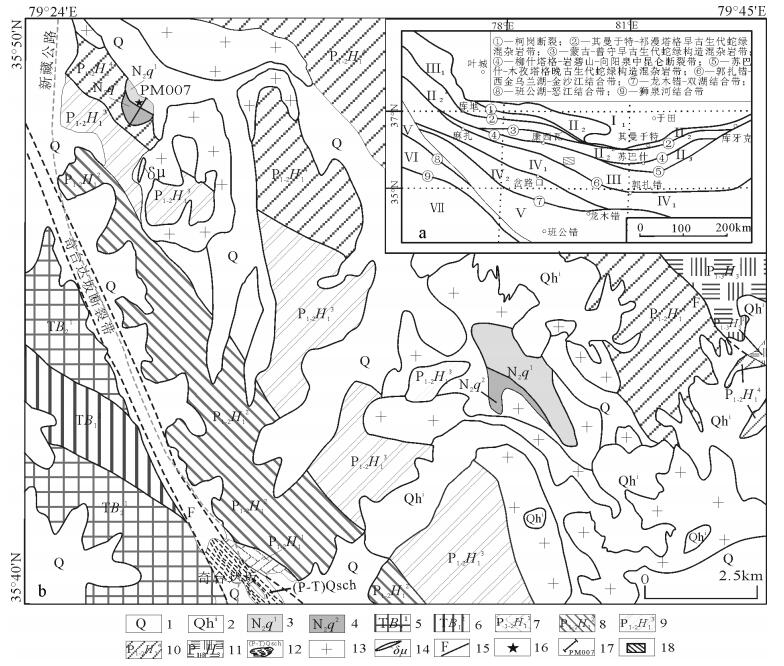
 下载:
下载:


